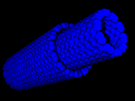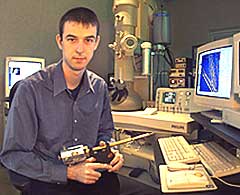| What could be the world's smallest bearings and
mechanical switches outside of those crafted by Mother Nature have been
fashioned by researchers with Berkeley Lab's Materials Sciences Division (MSD).
Working at the National Center for Electron Microscopy (NCEM), the
researchers custom-engineered seemingly frictionless bearings and switches
a few billionths of a meter in size (about ten thousand times smaller than
the diameter of a human hair) out of individual multi-walled carbon
nanotubes (MWNTs). These bearings and switches could prove immensely
valuable to the microscopic machines of today, called
micro-electromechanical systems or MEMS, and to their even smaller
descendants now being planned for the future.
 |

ILLUSTRATION OF A TELESCOPING NANOTUBE ACTING AS A LOW-FRICTION
BEARING
|
"We have demonstrated the controlled and reversible telescopic
extension of multi-walled carbon nanotubes, thus realizing ultralow-friction
nanoscale linear bearings and constant-force nanosprings," says John
Cumings, a graduate student in the UC Berkeley Physics Department working
in the laboratory of MSD and UCB physicist Alex Zettl. "Repeated
extension and retraction of telescoping nanotube segments revealed no wear
or fatigue on the atomic scale. Hence, these nanotubes may constitute near
perfect, wear-free surfaces."
In a paper which appeared in the July 28, 2000 issue of the journal Science,
Cumings and Zettl described how they were able to carefully remove the
capped end of a MWNT and extrude from it a smaller nanotube "much
like the telescoping of a mariner's traditional spyglass."
A MWNT is essentially an elongated form of the 60- and 70-atom clusters
of pure carbon called fullerenes or "buckyballs." Formed
naturally in the residue of vaporized carbon rods, MWNTs typically consist
of about five to 40 layers of graphite sheets curled and connected into a
concentric series of hollow cylinders with each cylinder closed and capped
on either end.
"Our procedure removes the caps from just the outer-shell
nanotubes while leaving the core nanotubes fully intact and
protruding," says Cumings. "We have used this technique inside a
high-resolution transmission electron microscope (TEM) to attach a movable
manipulator to only the core nanotubes within a MWNT."
The weak van der Waals bonds that make graphite such a good lubricant
do likewise for a telescoped nanotube and enable a core inner tube to move
in and out of its jacket like a well-oiled shaft moving in and out of its
sleeve. Those same van der Waals bonds also cause a fully extended core
tube to snap back into its jacket in less than ten billionths of a second,
raising the possibility of using telescoped nanotubes as really small and
really, really fast electromechanical switches.
Explains Cumings, "Because the core nanotube conducts electrically
to its housing, an extended core could bridge a gap between two metals,
closing a circuit. When the core nanotube is retracted, it would open the
circuit."
 |

JOHN CUMINGS AT THE NATIONAL CENTER FOR ELECTRON MICROSCOPY
|
This work by Cumings and Zettl holds great promise for MEMS, one of the
hottest items to hit the high technology market since integrated circuits.
Although the global market for MEMS is already in the billions of dollars,
the development and application of the technology has been hampered by
frictional wear and tear. Friction threatens to pose even more of a
problem for the next generation of shrinking technology, NEMS or
nanoelectronmechanical systems, devices that will be a thousand times
smaller than MEMS.
"The frictional forces we see are about a thousand times smaller
than you'd find in conventional MEMS devices made with silicon or silicon
nitride," says Cumings.
The absence of friction results from the surfaces between the outer and
inner nanotubes being atomically perfect and the spacing between them too
narrow to accommodate grit. Because each individual wall of carbon atoms
in a MWNT is likely to acquire a slightly different chirality (geometric
configuration) when it is rolled into a cylinder, the energy barrier to
rotation is also very small. This means that telescoped nanotubes should
work equally well as linear or rotational bearings.
Cumings and Zettl first created their telescoped nanotubes on NCEM's
Topcon 002b, a general purpose high-resolution TEM. They have since worked
on the Philips CM200 as well. Using a Scanning Tunneling Microscope (STM)
they adapted as a manipulator and working inside a special TEM stage they
built that enabled the manipulations to be observed in real time, the
researchers anchored a MWNT at one end with a stationary gold electrode
and peeled off a few outer layers from the other. This left a portion of
the unpeeled layers protruding as a second, smaller core tube from within
the larger outer tube that had been peeled. The researchers then
spot-welded the STM tip to this core tube and used it to pull or push the
tube back and forth.
"We saw no wear or fatigue up to 20 cycles of pushing and
pulling," says Cumings. "Because we're looking at the molecular
level, this means that there will be no wear if pushed and pulled a
million times."
Though the experiments were performed inside a TEM for purposes of
video-taping the procedure, the researchers say the technique can also be
performed "blind" and monitored from the electrical
characteristics of the MWNT alone. In addition, the "shaping"
electrode can easily be replaced by any coventional conducting substrate.
The spring action of the telescoped nanotubes was discovered when a
spot-weld broke and the inner tube that was being restrained immediately
retracted back to its original position. By putting an electrical charge
on the inner and outer tubes and altering the amount of this charge, it
should be possible to make a "nanoswitch" that could be opened
or closed at will.
The same technique used to make telescoped nanotubes can also be used
to sharpen MWNT into long, stiff and tapered electrically-conducting tips
for use as biological or scanned probes or for electron field emissions.
The unique mechanical and electrical properties of MWNTs -- they are
chemically inert, stronger than steel, and can be made into insulators,
conductors, semiconductors, or even superconductors -- opens the door to
their potential use in a wide variety of applications providing they can
be engineered into an appropriate shape.
In a second paper which appeared in the August 10 issue of the journal Nature,
Cumings and Zettl describe in detail how their technique for peeling off
the outer layers of a MWNT to make a telescoped nanotube can also be used
to sharpen the MWNT's tip down to a single wall of carbon atoms.
"With our technique, average MWNTs are easily converted into ideal
geometry tips for scanned probe, field emission, biological insertion, or
mechanical nanobearing applications," Cumings says.
Joining Cumings and Zettl on the Nature paper was former MSD
physicist Philip Collins, who is with IBM's T. J. Watson Research Center
in New York.
Additional Information:
|


